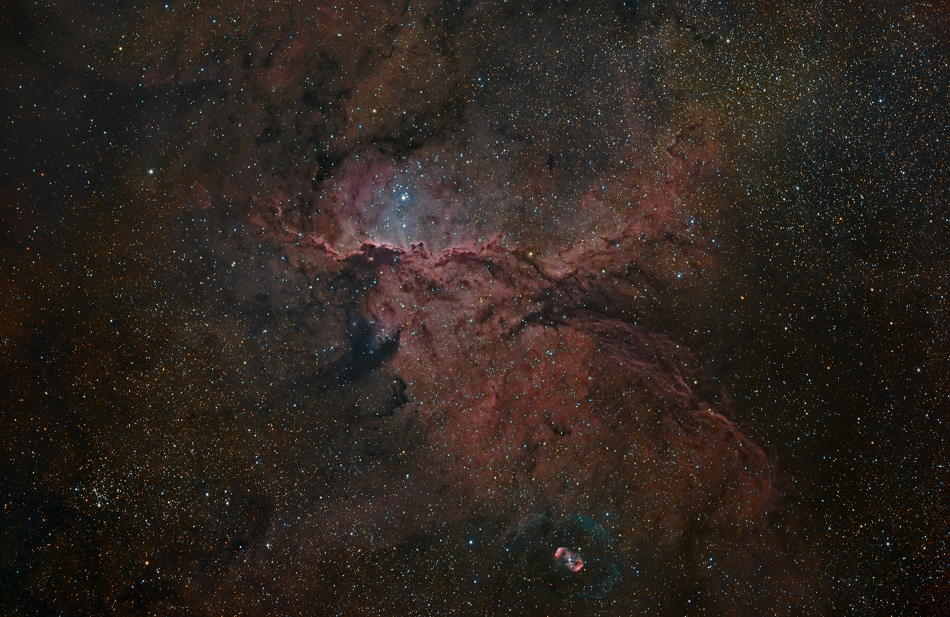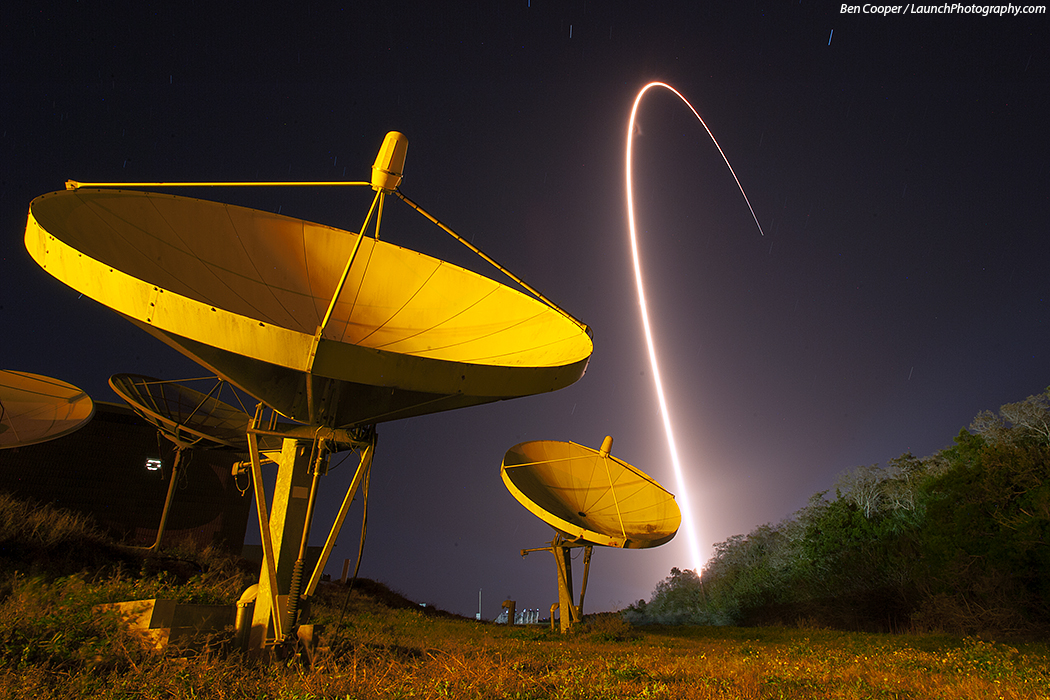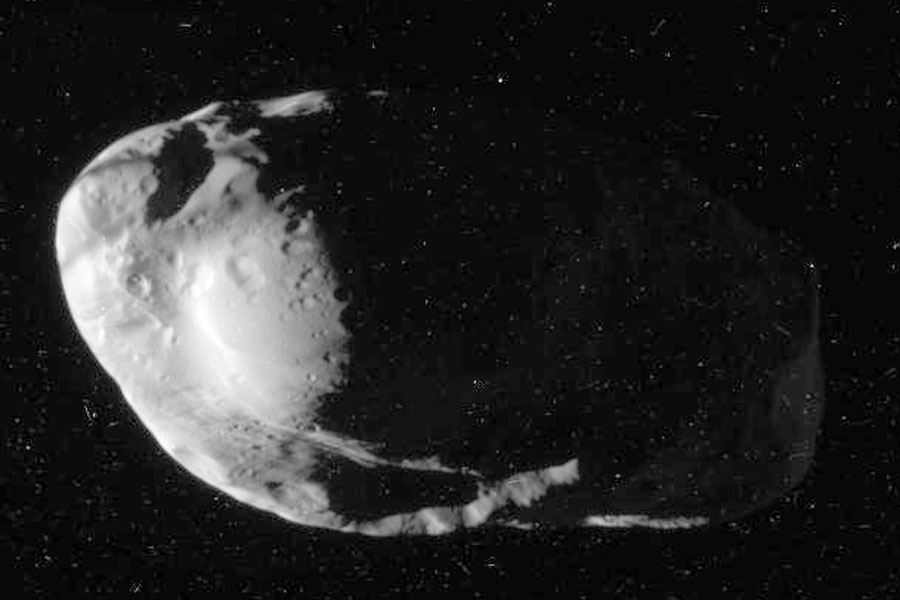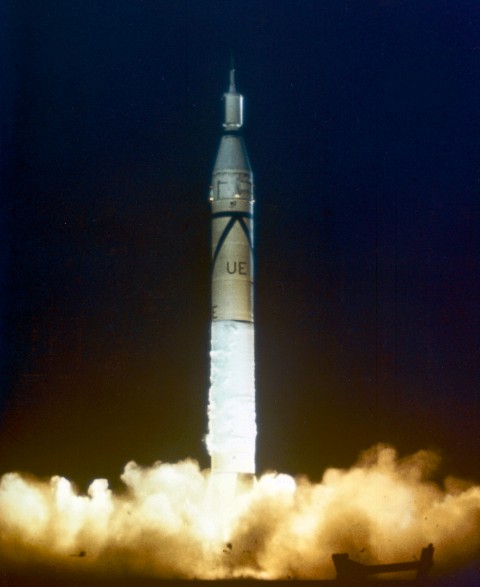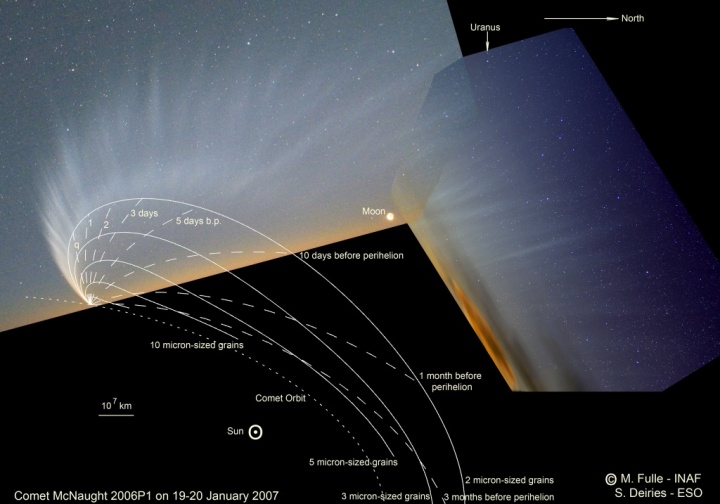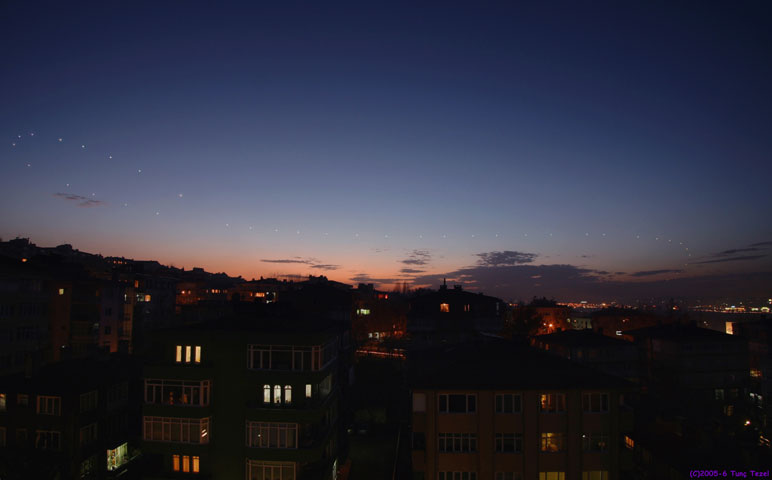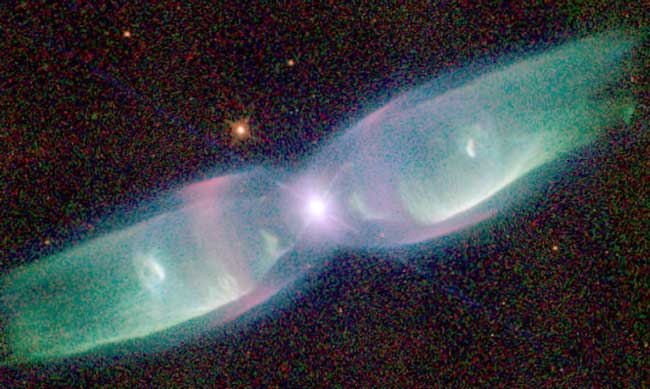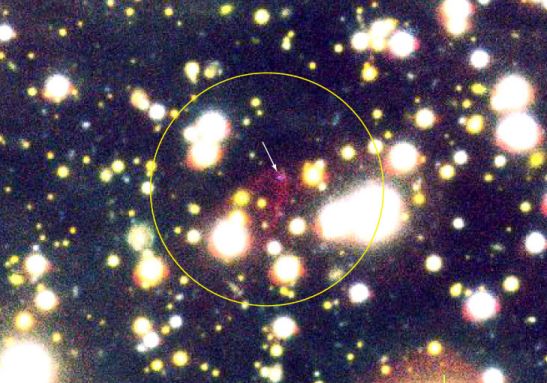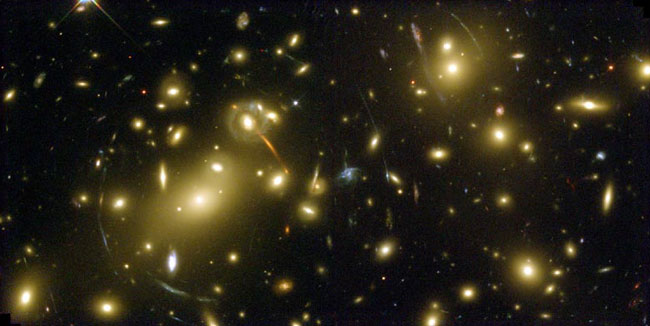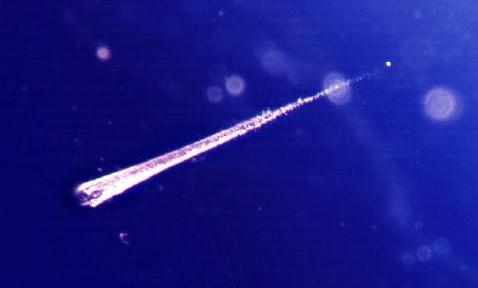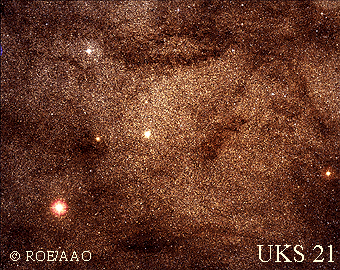| << Previous | Index | Next >> |
2015 These two mighty galaxies are pulling each other apart. Known as the "Mice" because they have such long tails, each spiral galaxy has likely already passed through the other. The long tails are created by the relative difference between gravitational pulls on the near and far parts of each galaxy. Because the distances are so large, the cosmic interaction takes place in slow motion -- over hundreds of millions of years. NGC 4676 lies about 300 million light-years away toward the constellation of Bernice's Hair (Coma Berenices) and are likely members of the Coma Cluster of Galaxies. The above picture was taken with the Hubble Space Telescope's Advanced Camera for Surveys in 2002. These galactic mice will probably collide again and again over the next billion years until they coalesce to form a single galaxy.
2014 Fantastic shapes lurk in clouds of glowing gas in NGC 6188, about 4,000 light-years away. The emission nebula is found near the edge of a large molecular cloud unseen at visible wavelengths, in the southern constellation Ara. Massive, young stars of the embedded Ara OB1 association were formed in that region only a few million years ago, sculpting the dark shapes and powering the nebular glow with stellar winds and intense ultraviolet radiation. The recent star formation itself was likely triggered by winds and supernova explosions, from previous generations of massive stars, that swept up and compressed the molecular gas. Joining NGC 6188 on this cosmic canvas is rare emission nebula NGC 6164, also created by one of the region's massive O-type stars. Similar in appearance to many planetary nebulae, NGC 6164's striking, symmetric gaseous shroud and faint halo surround its bright central star near the bottom edge. The impressively wide field of view spans over 3 degrees (six full Moons), corresponding to over 200 light years at the estimated distance of NGC 6188. Narrowband image data has been included in the natural looking color composite, adding to deep red emission from hydrogen and sulfur atoms and the blue-green light of oxygen atoms.
2013 Beyond a fertile field of satellite communication antennas at Kennedy Space Center, an Atlas V rocket streaks into orbit in this long exposure photograph. In the thoughtfully composed image recorded on the evening of January 30, the antennas in the foreground bring to mind the rocket's payload, a Tracking and Data Relay Satellite (TDRS; sounds like TEE-dress). This TDRS-K is the first in a next-generation series adding to the constellation of NASA's communication satellites. Operating from geosynchronous orbit 22,300 miles (36,000 kilometers) above planet Earth, the network of TDRS satellites relays communications, data, and commands between spacecraft and ground stations. Formerly the TDRS network provided communications for space shuttle missions. In fact, many TDRS satellites were ferried as far as low Earth orbit on space shuttles. The TDRS network continues to support major spacecraft like the International Space Station, the Hubble Space Telescope, and the Fermi Gamma-ray Space Telescope.
2012
[imghover6=http://apod.nasa.gov/apod/image/1202/re ... ey_960.jpg]http://apod.nasa.gov/apod/image/1202/re ... otated.jpg[/imghover6]Credit & Copyright: Alex Cherney (Terrastro, TWAN)
2011
Click to play embedded YouTube video.
Credit & Copyright: Charles & Ray Eames (Eames Office)
2010 Another moon of Saturn has been imaged in detail by the Cassini spacecraft. Orbiting Saturn since 2004, the robotic Cassini got its closest look yet at Saturn's small moon Prometheus last week. Visible above in an unprocessed image from 36,000 kilometers away, Prometheus' 100-km long surface was revealed to have an interesting system of bulges, ridges, and craters. These features, together with the moon's oblong shape and high reflectivity, are now being studied to help better understand the history of Prometheus and Saturn's rings. Prometheus is one of the few shepherd satellites known, as its gravity, along with its companion moon Pandora, confines many smaller ice chucks into Saturn's F Ring. Cassini's next major targeted flyby is of the moon Rhea on March 2.
2009 Higher than highest communications tower, higher than highest mountain, higher than highest airplane, lies the realm of the aurora. Auroras rarely reach below 60 kilometers, and can range up to 1000 kilometers. Aurora light results from energetic electrons and protons striking molecules in the Earth's atmosphere. Frequently, when viewed from space, a complete aurora will appear as a circle around one of the Earth's magnetic poles. This particularly rare purple auroral corona occurred in 2004 high above Harstad, Norway.
2008 Fifty years ago (on January 31, 1958) the First Explorer, was launched into Earth orbit by the Army Ballistic Missile Agency. Inaugurating the era of space exploration for the United States, Explorer I was a thirty pound satellite that carried instruments to measure temperatures, and micrometeorite impacts, along with an experiment designed by James A. Van Allen to measure the density of electrons and ions in space. The measurements made by Van Allen's experiment led to an unexpected and startling discovery -- an earth-encircling belt of high energy electrons and ions trapped in the magnetosphere now known as the Van Allen Radiation Belt. Explorer I ceased transmitting on February 28, 1958, but remained in orbit until March of 1970. Pioneering space scientist James Van Allen died on August 9th, 2006 at the age of 91.
2007 By January 19/20 Comet McNaught's magnificent dust tail stretched for about 150 million kilometers (~1 AU), requiring images from both southern and northern hemispheres of planet Earth to take it all in. Two such views - from Cerro Paranal in Chile (left) and the Carnic Alps in Italy - are combined in this unique graphic that also outlines a perspective view of the comet's orbit (dotted line) and relative position of the Sun. Driven by solar radiation pressure the dust tail initially points away from the Sun, but also trails outside the comet's orbit. Astronomers try to account for the complex structure along the tail, including the pronounced striations, by considering forces acting on the dust (e.g. gravity, solar wind and radiation) as well as the release time and size of the dust grains. In the diagram, the modeled location of dust grains released at approximately the same time relative to perihelion passage, synchrones, are shown as dashed lines. The location of grains of similar size, syndynes, are shown as solid lines.
2006 Is that Venus or an airplane? A common ponderable for sky enthusiasts is deciding if that bright spot near the horizon is the planet Venus. Usually, an airplane will show itself by moving significantly in a few moments. Venus will set only slowly as the Earth turns. Still, the identification would be easier if Venus did not keep shifting its position each night. Pictured above, Venus was captured 38 different nights during 2005 and 2006 over Bursa, Turkey, when Earth's sister planet appeared exclusively in the evening sky. The average spacing of the images was about five days, while the images were always taken with the Sun about 7 degrees below the horizon. Venus' orbit around the Sun will now confine it to Earth's morning sky until October 2006.
2005 What has happened to Saturn's moon Iapetus? A strange ridge crosses the moon near the equator, visible near the bottom of the above image, making Iapetus appear similar to the pit of a peach. Half of Iapetus is so dark that it can nearly disappear when viewed from Earth. Recent observations show that the degree of darkness of the terrain is strangely uniform, like a dark coating was somehow recently applied to an ancient and highly cratered surface. The other half of Iapetus is relatively bright but oddly covered with long and thin streaks of dark. A 400-kilometer wide impact basin is visible near the image center, delineated by deep scarps that drop sharply to the crater floor. The above image was taken by the Saturn-orbiting Cassini spacecraft during a flyby of Iapetus at the end of last year.
2004 Are stars better appreciated for their art after they die? Actually, stars usually create their most artistic displays as they die. In the case of low-mass stars like our Sun and M2-9 pictured above, the stars transform themselves from normal stars to white dwarfs by casting off their outer gaseous envelopes. The expended gas frequently forms an impressive display called a planetary nebula that fades gradually over thousand of years. M2-9, a butterfly planetary nebula 2100 light-years away shown in representative colors, has wings that tell a strange but incomplete tale. In the center, two stars orbit inside a gaseous disk 10 times the orbit of Pluto. The expelled envelope of the dying star breaks out from the disk creating the bipolar appearance. Much remains unknown about the physical processes that cause planetary nebulae.
2003 The lonely RX J1856.5-3754 was formed from the collapsed core of an exploding star. At a distance of 180 light-years it is the closest known neutron star. More massive than the Sun but only 20 kilometers across, this tiny stellar juggernaut plows through the hydrogen gas and dust clouds of interstellar space at about 200 kilometers per second. The surface of the neutron star is fantastically hot, around 700,000 degrees Celsius, making it detectable with orbiting x-ray telescopes. But optical astronomers were surprised to discover that RX J1856.5-3754 is also surrounded by a cone-shaped nebula. Indicated in this deep image from the European Southern Observatory's Kueyen telescope, the nebula glows in the red light of ionized hydrogen atoms recombining with electrons. Its cone shape is analogous to the bow wave of a ship plowing through water. A faint blue dot near the tip of the cone is the neutron star itself. The nebula appears to have formed very near the surface of the neutron star and astronomers are trying to determine if the observed densities and temperatures can explain the nebula's appearance.
2002 Where does a two-ton tiger hang out? Well, in this case the Trans-Iron Galactic Element Recorder (TIGER) experiment hangs from a mobile crane on the far left in this panorama photo recorded last December near McMurdo Station, Antarctica. The helium-filled balloon which carried TIGER aloft for a record setting 31+ days is stretched out far to the right (scroll right) against the background of majestic Mt. Erebus, the southernmost active volcano in the world. While cruising with its two-ton payload above 100,000 feet, the scientific balloon's fully inflated internal volume was roughly the same as the Louisiana Superdome, but its walls were as thin as shrinkwrap. TIGER was designed to detect the unexplained galactic cosmic rays -- atomic nuclei moving at near light-speed which impinge on the Earth from outside our Solar System. By making the first sensitive measurements of cosmic rays with atomic numbers between 26 (Iron) and 40 (Zirconium), TIGER investigators will seek to identify the type of astrophysical environments which could be sources of the galactic cosmic-ray material and possible ways in which the nuclei are accelerated to such high speeds.
2001 Gas giant Jupiter is the solar system's largest world with about 320 times the mass of planet Earth. Famous for its Great Red Spot, Jupiter is also known for its regular, equatorial cloud bands, visible in very modest sized telescopes. The dark belts and light-colored zones of Jupiter's cloud bands are organized by planet girdling winds which reach speeds of up to 500 kilometers per hour. On toward the Jovian poles though, the cloud structures become more mottled and convoluted until, as in this Cassini spacecraft mosaic of Jupiter, the planet's polar region begins to look something like a brain! This striking equator-to-pole change in cloud patterns is not presently understood but may be due in part to the effect of Jupiter's rapid rotation or to convection vortices generated at high latitudes by the massive planet's internal heat loss. The Cassini spacecraft recorded this dramatically detailed view of Jupiter during its turn of the millennium flyby enroute to Saturn.
2000 Gravity can bend light. Almost all of the bright objects in this recently released Hubble Space Telescope image are galaxies in the cluster known as Abell 2218. The cluster is so massive and so compact that its gravity bends and focuses the light from galaxies that lie behind it. As a result, multiple images of these background galaxies are distorted into long faint arcs - a simple lensing effect analogous to viewing distant street lamps through a glass of wine. The cluster of galaxies Abell 2218 is itself about three billion light-years away in the northern constellation Draco.
1999 Last week, Japan's new Subaru Telescope made its first observations of the sky. The gray building housing Subaru is visible just left of the white Keck domes near the photo's center. Subaru is the latest in the class of optical telescopes using a mirror with a diameter greater than 8 meters. Subaru's 8.3-meter primary is the largest single-piece optical telescope mirror yet made, and is so thin that its precise shape can be monitored and adjusted. Subaru will be owned and operated by Japan but located at the top of Hawaii's Mauna Kea, a dormant volcano famous for housing several of the world's leading telescopes.
1998
1997 This carrot shaped track is actually little more than 5 hundredths of an inch long. It is the trail of a meteroid through aerogel exposed to space by the shuttle launched EURECA (European Recoverable Carrier) spacecraft. The meteoroid itself, about a thousandth of an inch in diameter, is visible where it came to rest, just beyond the tip of the carrot (far right). Chemical analyses of interplanetary dust particles similar to this one suggest that some of them may be bits of comets and represent samples of material from the early stages of the formation of the Solar System. NASA's Stardust mission, planned for launch in 1999, will attempt to directly collect dust from the tail of a comet and return it to Earth -- the first non-lunar sample return mission ever! In addition to peering into the chemistry and history of the solar system, the composition of cometary dust has important implications for the possibility of past life on Mars.
1996
| << Previous | Index | Next >> |

